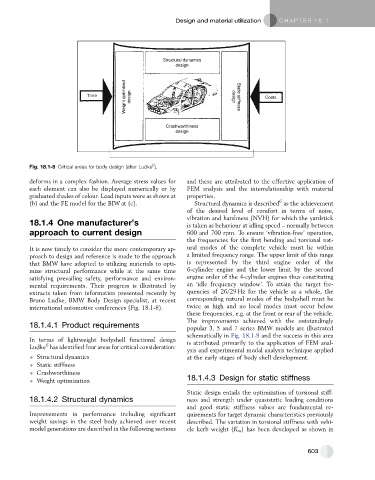Page 592 - Automotive Engineering Powertrain Chassis System and Vehicle Body
P. 592
Design and material utilization C HAPTER 18.1
Structural dynamics
design
Weight optimized design design Static stiffness Costs
Time
Crashworthiness
design
6
Fig. 18.1-8 Critical areas for body design (after Ludke ).
deforms in a complex fashion. Average stress values for and these are attributed to the effective application of
each element can also be displayed numerically or by FEM analysis and the interrelationship with material
graduated shades of colour. Load inputs were as shown at properties.
6
(b) and the FE model for the BIW at (c). Structural dynamics is described as the achievement
of the desired level of comfort in terms of noise,
vibration and harshness (NVH) for which the yardstick
18.1.4 One manufacturer’s is taken as behaviour at idling speed – normally between
approach to current design 600 and 700 rpm. To ensure ‘vibration-free’ operation,
the frequencies for the first bending and torsional nat-
It is now timely to consider the more contemporary ap- ural modes of the complete vehicle must lie within
proach to design and reference is made to the approach a limited frequency range. The upper limit of this range
that BMW have adopted to utilizing materials to opti- is represented by the third engine order of the
mize structural performance while at the same time 6-cylinder engine and the lower limit by the second
satisfying prevailing safety, performance and environ- engine order of the 4-cylinder engines thus constituting
mental requirements. Their progress is illustrated by an ‘idle frequency window’. To attain the target fre-
extracts taken from information presented recently by quencies of 26/29 Hz for the vehicle as a whole, the
Bruno Ludke, BMW Body Design specialist, at recent corresponding natural modes of the bodyshell must be
international automotive conferences (Fig. 18.1-8). twice as high and no local modes must occur below
these frequencies, e.g. at the front or rear of the vehicle.
The improvements achieved with the outstandingly
18.1.4.1 Product requirements popular 3, 5 and 7 series BMW models are illustrated
schematically in Fig. 18.1-9 and the success in this area
In terms of lightweight bodyshell functional design is attributed primarily to the application of FEM anal-
6
Ludke has identified four areas for critical consideration:
ysis and experimental modal analysis technique applied
Structural dynamics at the early stages of body shell development.
Static stiffness
Crashworthiness
Weight optimization 18.1.4.3 Design for static stiffness
Static design entails the optimization of torsional stiff-
18.1.4.2 Structural dynamics ness and strength under quasistatic loading conditions
and good static stiffness values are fundamental re-
Improvements in performance including significant quirements for target dynamic characteristics previously
weight savings in the steel body achieved over recent described. The variation in torsional stiffness with vehi-
model generations are described in the following sections cle kerb weight (K w ) has been developed as shown in
603

